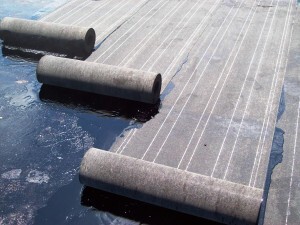Choosing the right commercial roofing system is a critical decision for any property manager or building owner. Two of the most common flat roofing options on the market today are Modified Bitumen (asphalt-based systems) and TPO (Thermoplastic Polyolefin). Each offers unique benefits and trade-offs depending on your building's needs, budget, and long-term maintenance strategy.
In this guide, we'll break down the key differences between these two roofing systems—so you can make an informed, confident decision for your property.
What Is Modified Bitumen Roofing?

Modified bitumen is an asphalt-based roofing system designed for flat or low-slope commercial roofs. It typically consists of reinforcing sheets made from glass fiber, polyester, and/or polyethylene, factory-coated with rubberized asphalt, and installed in multiple plies.
Common application methods include:
Hot mopping
Torch-down
Cold adhesive
This multi-layer approach creates a durable, time-tested roofing membrane—especially suitable for repairing or replacing older built-up roofs.
Pros of Modified Bitumen Roofs
1. Proven Track Record
SBS-modified bitumen systems have been used in the U.S. since the 1970s. Their long history in commercial roofing makes them a trusted choice, especially for facilities with existing bituminous systems.
2. Multiple Application Methods
You can apply modified bitumen via torch, mop, or cold adhesive, offering flexibility to suit various jobsite conditions and budgets.
3. High Durability and Redundancy
The multi-ply construction helps resist punctures, weathering, and foot traffic, offering excellent protection over time.
4. Ideal for Repairs and Retrofits
Modified bitumen membranes work well in patching or overlaying older asphalt-based roofs.
Cons of Modified Bitumen Roofs
1. Labor-Intensive Installation
To meet performance standards, most modified bitumen systems require at least two plies—a base and cap sheet—plus extra layers at corners and flashings. This adds to labor and material costs.
2. Installation Skill Matters
Proper adhesion at lap seams, correct asphalt temperatures, and skilled torching or mopping techniques are critical for performance—leaving more room for installation errors.
3. Hot Asphalt Challenges
Many systems still rely on hot kettles, which can be messy, odorous, and require additional safety precautions.
4. Not Ideal for Ponding Water
Modified bitumen is not recommended for roofs with persistent ponding, and may fail in recover applications where moisture is trapped beneath.
5. Declining Popularity
With the rise of single-ply systems, modified bitumen now makes up less than 30% of new commercial roofs, primarily due to rising asphalt costs and a shrinking labor pool trained in hot-application techniques.
What Is TPO Roofing?
TPO (Thermoplastic Polyolefin) is a single-ply roofing membrane made from a blend of rubber and plastic polymers. It's part of the thermoplastic elastomeric family, meaning it can be heat-welded during installation and recycled later—offering both performance and environmental benefits.
TPO is one of the fastest-growing commercial roofing systems today, commonly used in large-scale flat roof installations due to its energy efficiency and ease of installation.
Pros of TPO Roofing
1. Energy Efficiency
TPO membranes are typically white or light-colored, reflecting UV rays and lowering rooftop temperatures—making them an excellent choice for reducing cooling costs.
2. Fast, Cost-Effective Installation
As a single-ply system, TPO installs faster than multi-layer systems like modified bitumen—translating to lower labor costs and less downtime.
3. Heat-Welded Seams for Strength
Unlike glued seams, TPO uses hot-air welding, creating a strong, watertight bond that's highly resistant to leaks.
4. Resistant to Chemicals and UV
TPO resists ozone, algae growth, and many industrial pollutants—making it ideal for commercial and industrial settings.
5. Recyclable and Eco-Friendly
At the end of its lifecycle, TPO can be reprocessed into new roofing materials, supporting sustainability initiatives.
Cons of TPO Roofing
1. Product Quality Varies by Manufacturer
Because TPO is relatively new compared to modified bitumen, formulas can differ between brands, making it critical to choose a reputable supplier and installer.
2. May Be Prone to Punctures
TPO is typically thinner than modified bitumen, so puncture resistance can be a concern, especially on roofs with heavy foot traffic or equipment.
3. Performance Depends on Proper Welding
If seams are not heat-welded correctly, TPO systems can be vulnerable to leaks over time.
Which Roofing System Is Right for You?
The best choice depends on your building's needs, budget, and long-term maintenance plan. Here's a quick side-by-side comparison:
Feature |
Modified Bitumen |
TPO |
Layers |
Multi-ply |
Single-ply |
Durability |
Very high |
High, but puncture-prone |
UV Resistance |
Moderate |
Excellent |
Energy Efficiency |
Low |
High (cool roof) |
Installation Complexity |
High |
Moderate |
Recyclability |
Limited |
Yes |
Best For |
Retrofits, redundancy |
New builds, energy savings |
Final Thoughts
Both modified bitumen and TPO systems offer reliable solutions for commercial roofing—but they're not one-size-fits-all. Modified bitumen shines in high-impact environments and retrofits, while TPO is ideal for energy-conscious owners seeking fast, cost-effective installation.
If you're unsure which system is right for your building, we're here to help.
Book a roof consultation with our experts at Best Roofing to get a tailored recommendation based on your building, budget, and performance needs.



